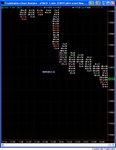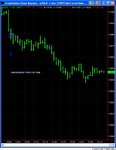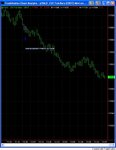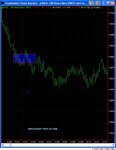Invisible hooks - for educational purposes only
This is added for educational purposes to supplement, not refute, the posts on RH in this thread. For those who are wondering or studying what happens internally ‘inside’ an RH, the first attached jpg illustrates, in terms of aggressive volume, an ‘invisible’ hook . While actual ‘by the book’ hooks showed up later, this ‘invisible’ one followed a forceful directional bar. ie imo quality RH’s don’t just happen anywhere, but where momentum is at increased levels. Then, in this ‘invisible’ hook, increased aggressive buying AND aggressive selling occurred (price action inside rectangle shown on invisible hook .jpg) with the odds ( by Joe) of course favoring continuation of the thrust. Subsequent price action shows (on bar chart shown on SubsequentPriceAction.jpg) that position taken on this hook took little heat (and btw has broken down out of more ‘hooks’ by another 20-30 ticks since picture was taken). Hopefully, this will give us some clues about what the 'auction' is doing during the formation of a hook and help ferret out the best setups.
This is added for educational purposes to supplement, not refute, the posts on RH in this thread. For those who are wondering or studying what happens internally ‘inside’ an RH, the first attached jpg illustrates, in terms of aggressive volume, an ‘invisible’ hook . While actual ‘by the book’ hooks showed up later, this ‘invisible’ one followed a forceful directional bar. ie imo quality RH’s don’t just happen anywhere, but where momentum is at increased levels. Then, in this ‘invisible’ hook, increased aggressive buying AND aggressive selling occurred (price action inside rectangle shown on invisible hook .jpg) with the odds ( by Joe) of course favoring continuation of the thrust. Subsequent price action shows (on bar chart shown on SubsequentPriceAction.jpg) that position taken on this hook took little heat (and btw has broken down out of more ‘hooks’ by another 20-30 ticks since picture was taken). Hopefully, this will give us some clues about what the 'auction' is doing during the formation of a hook and help ferret out the best setups.




